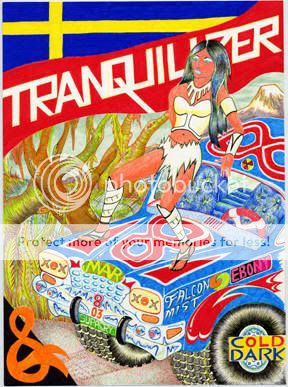This review ran in the Comics Journal a while back.
The visual arts have long been, keen on comics. From Roy Lichtenstein to the art-school trained members of Paper Rad to the recent Masters of Comics Art exhibition, high art institutions and practitioners are perfectly happy to appropriate, create, and interact with comics in various ways.
The reverse is less true. Certainly, there are comics creators who move in the high-art gallery world – but rarely without a chip on their shoulders. RAW’s self-promotional copy repeatedly and reflexively insisted on comics’ unique high-brow/low-brow status — though how anyone could mistake RAW for anything but high-brow is pretty unclear. And while artists may dip into and appropriate comics in various ways, comics creators rarely seem to pay much attention to what’s going on in the contemporary gallery scene. When I’ve glanced at such discussions on TCJ’s message board, I’ve been amazed at the level of animosity expressed toward the visual arts. The consensus seems to be that people who show in galleries are a bunch of talentless scam artists, emperors trying to cover their exposed peters with jars of urine and elephant dung.
I know that dada is only about a century old, and that, as such, it’s a bit much to expect comics professionals to get their minds around it. But even if you hate Duchamp and all his sneering progeny, there’s still heaps of worthy art out there. I go to galleries only occasionally, and I’ve seen plenty of visual art which focuses on strong representational illustration, narrative, and humor — art which should, in other words, appeal to a comics audience.
As just one example, take Chicago artist Ryan Christian. His drawings are semi-surreal in the best sense — that is, they’re quirky, unexpected, and funny. In fact, many of his illustrations function as single-panel cartoons. An image of a dinosaur torso affixed to a pair of naked male legs being threatened by a meteor with spread female genitalia caused me to laugh out loud. Somewhat more abstruse, but still quite entertaining, is a tiny drawing of a terrorist psychically destroying the head of a hapless basketball player as both stand in a bathtub. And Christian’s series of pieces featuring giant, dripping, copulating mud-entities looks like it would be at home in any number of underground-influenced comics anthologies — such as Legal Action Comics, for example.
As I said, Christian is just starting out, and while I like these pieces, I don’t love them. In part, the problem is a disconnect between form and content. Christian’s meteor/dinosaur/genitalia illustration could almost have been done by Gary Larson or Johnny Ryan — but both of those creators use a loose style which seems perfectly fitted to absurd, off-hand jokes. Christian, on the other hand, is an extremely tight illustrator, with a gift for subtle shading. The combination of beautiful line-work and throw-off one-liners makes the images come off as a little smug or cutesy, rather than as energetically gratuitous.
In some of his most recent work, though, Christian addresses these problems, and the results are dazzling. Rather than the sharply clean delineations between figures and (mostly empty) background in his earlier pieces, he has now started to incorporate elaborate moire patterns. At the same time, he’s moved away from the dryness of surrealism and toward a more pulpy mysticism. The result is ambiguous wizard-things floating through gorgeously patterned space. Again, Christian is a lot less sloppy than the Paper Rad crowd, but his work recalls theirs in some ways — that is, it touches on popular culture before wandering off into pure evocative eye-candy. Not only is the work lovely in itself, but — given the speed with which Christian seems to be developing — it shows enormous promise. I’m looking forward to seeing what he’s doing in two or three years.
Another gallery artist who should by all rights excite comics fans is Neil Whitacre. Whitacre is a significantly more established figure than Christian, and his work is quite different. Where Christian’s drawings suggest cartoons — either through punch-lines or simplified figures — Whitacre’s work seems much more closely related to classic illustration. For example, one of my favorite Whitacre images shows a lanky, hairy, hippieish mountain-man sitting on what seems to be a tiny island, toasting a marshmallow by the waterside. The water is represented by smoothly undulating, broad inky strokes; the island foliage is an interwoven net; the night sky is stippled grey with some darker branches just peeking through. On the hippie’s shoulder sits a large, fluid white bird of indeterminate species.
The elegant, off-center composition, as well as the intricate use of different shades and patterns, suggests Japanese prints. And like those prints, the particularity of the details and the vividness of the scene makes it hard not to feel that there is a story before and after, of which we see only a single instant — or one panel, if you prefer. There’s obviously a sense of reflection here, but the very use of stillness points to motion outside the frame. This is a contemplative high-art moment, but its energy or weight relies in part on an obscure, never-quite-defined genre narrative of wilderness adventure.
Whitacre manages to be indisputably high-art while retaining a low-art energy and verve — in other words, the holy grail of comicdom aesthetes, which calls to many but is seized by almost none. Whitacre’s color work may make this even more apparent; for example, a red, black, and blue image of a black cowboy riding a hammerhead shark is garish, tripped-out, trashy biker art of the sort that would make Juxtapoz magazine aficionados salivate. And yet, the image isn’t at all messy. Instead, the blue twisting patterns on the shark and the stylized flames drifting up and off-panel look like art nouveau wallpaper. Its absurd but restrained, evoking both the tasteless fussiness of flash tattoos and the tasteful fussiness of upper-crust decorative traditions — both masculine swagger and feminine delicacy. It’s clearly making fun of the first— whether located in the image of the cowboy, or the working-class artist, or, perhaps, in the racially oppressed. But the cowboy’s awkward, thrown-back pose, and the delicacy of the patterns, is also elegaically romantic. And, of course, Whitacre’s line-work is such that any piece he does is going to swagger more than a little anyway.

Neil Whitacre, Tranquilizer (No, not the image I talk about in the text; sorry about that.)
Neither Whitacre nor Christian is especially indebted to comics for material or inspiration. But neither do they reject it. Both have expressed interest in various comic artists (Christian is a fan of Paper Rad, Whitacre of Basil Wolverton). And both have thought about working in something like comics form. Christian has a zine coming out shortly called “Lonesome Dandy Quarterly.” Whitacre says he’s an “aspiring comics writer.” He’s currently working on a comic-like series called “Into the Abyss” about “a small-scale entrepreneur of sorts.” In other words, for both these artists, comics provoke interest, curiosity, and even ideas…but not anxiety. Comics, in other words, make the visual arts richer. The reverse is occasionally true as well, of course. But it would be nice if it were the case more often.
__________________
More Neil Whitacre images here and here
Ryan Christian’s blog is here


Is it comics?
I say it isn’t!
Philistine.